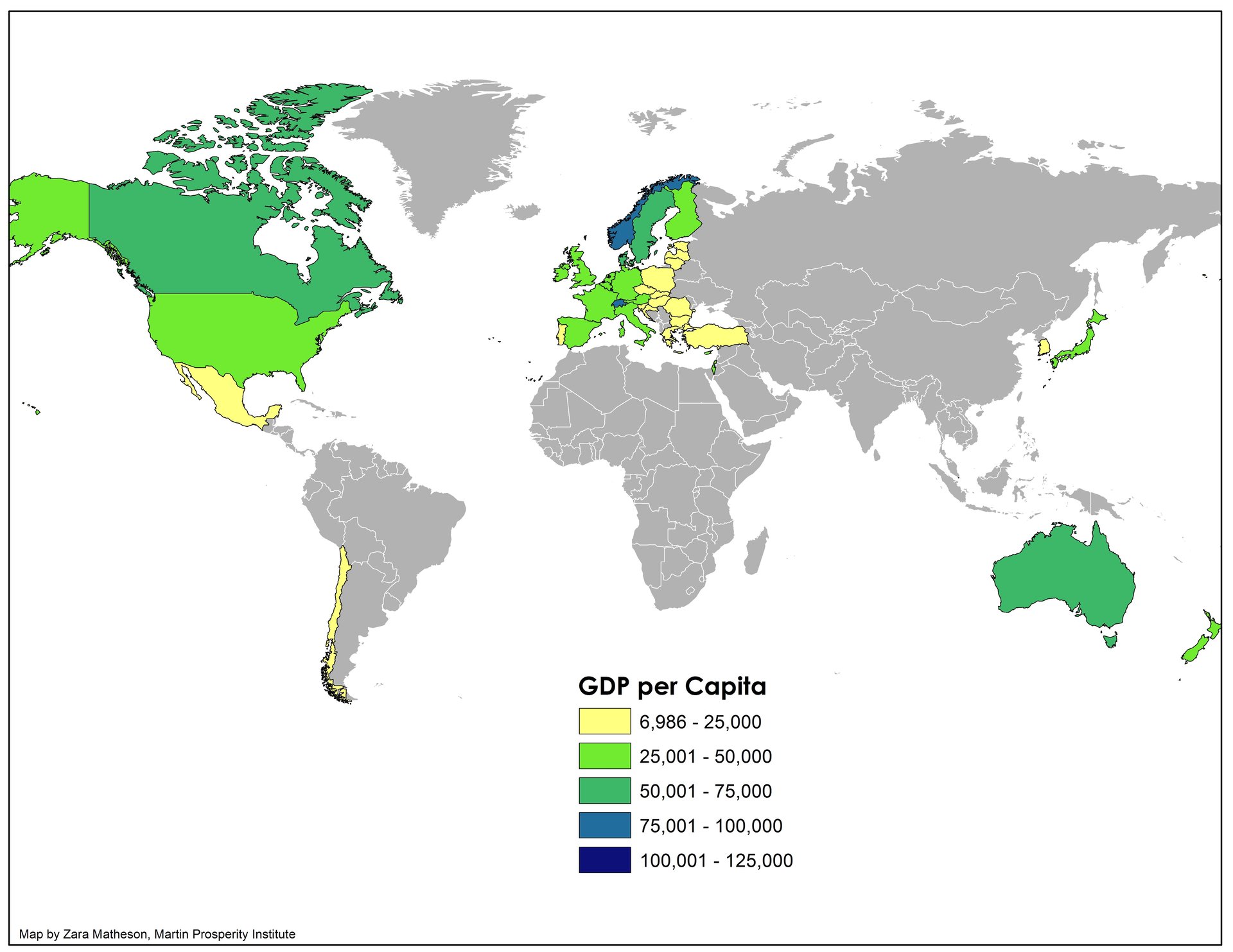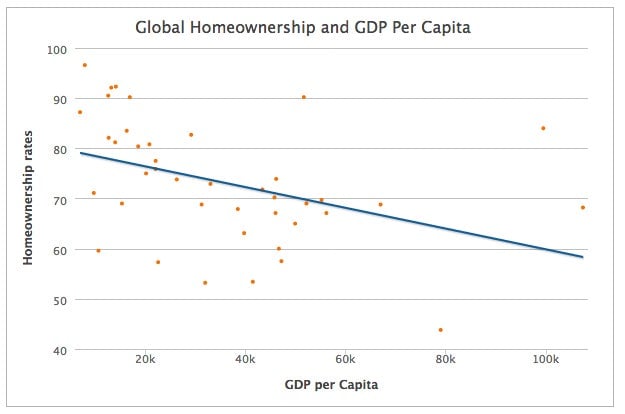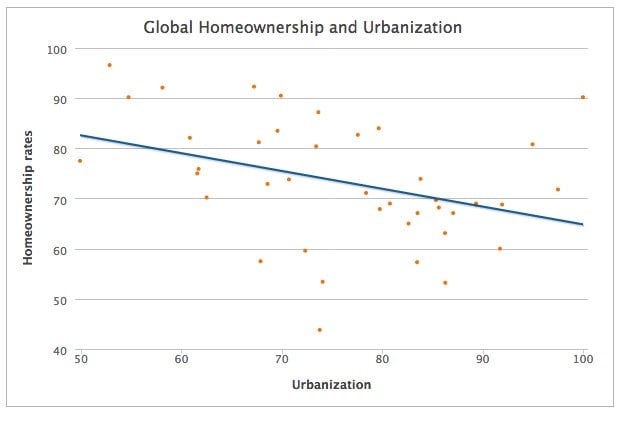Why the US needs to fall out of love with home ownership
“The most tangible cornerstone that lies at the heart of the American Dream, at the heart of middle-class life,” Barack Obama declared in a speech this summer, is “the chance to own your own home.”

“The most tangible cornerstone that lies at the heart of the American Dream, at the heart of middle-class life,” Barack Obama declared in a speech this summer, is “the chance to own your own home.”
Politicians and pundits across the spectrum regard homeownership both as the best investment a family can make and a measure of national prosperity. But a significant majority of Americans believe differently. According to a 2012 Pew survey, 86% of Americans now believe the key to a middle-class life is a “secure job,” almost double the share (45%) who say the same about owning their home. To compare, seven out of 10 respondents to a Time/CNN/Yankelovich survey back in 1991 said that homeownership was essential to middle class membership, while just one-third said that a white-collar job was required. Since 2004, the overall rate of homeownership in the US has declined from 69.2% to 65%.
To help us better understand just how much we should—or shouldn’t—lament the shift away from homeownership, my colleagues at the Martin Prosperity Institute and I took a closer look at the relationship between homeownership levels and the overall economic health. And what we found should make the president and politicians rethink their pro-homeownership stance.

The map above by the MPI’s Zara Matheson shows the percentage of the population that own their own homes across 41 nations, based on data from Pew, which collected it from numerous sources. The Pew data cover 42 nations—all nations that are members of the OECD and the European Union, plus Singapore. We excluded Iceland from the analysis based on missing data for other variables, giving us 41.
As it turns out, homeownership rates in the US are relatively low in comparison to other nations. The US ranks 33rd of these 41 nations, slightly below the Netherlands and just above France. Romania, Lithuania and Croatia have the highest levels of homeownership. Switzerland, New Zealand and Germany have the lowest.

The second map, also by Matheson, shows the level of overall economic development, measured as economic development per person for the same countries, based on data from the World Development Indicators. The map is nearly the opposite of the first one.
Countries with high rates of homeownership were significantly less economically productive.
Switzerland, which has the lowest rate of homeownership among the countries Pew studied, is one of the the world’s richest and most advanced countries—on this map, an island of dark blue in a sea of green. At the other end of the spectrum, the string of less-developed Eastern European nations, with lower levels of GDP per capita, are also some of the countries with the highest levels of homeownership on the first map. The US and Canada are green on both maps. They combine relatively high levels of economic development with relatively low levels of homeownership.
To get a better handle on this connection between property ownership and economic productivity, my colleague Charoltta Mellander ran a simple correlation analysis between homeownership and economic output (based on GDP) per person. The scatter-graph below plots the pattern. Though correlation is not causation, the trend is striking.

Less developed countries have consistently higher levels of homeownership, while more advanced nations combine higher levels of economic development with substantially lower levels of homeownership. (The correlation between the two is -.40 overall and it rises to -.58 when she removed outliers Singapore, Norway, Luxembourg and Switzerland). American political rhetoric tends to equate rising homeownership rates with strong economic development. Instead, the opposite is true. The rate of homeownership declines as nations get wealthier.
One reason for this may be because people in less-developed nations have fewer options of where to put their money. In agrarian economies, land ownership is the basic source and measure of wealth. In more advanced capitalist economies, people have many more investment options. Many of the places with the highest rates of homeownership are in former Communist nations of Eastern Europe.
Lower rates of homeownership also appear to follow from urbanization. The scatter-graph below illustrates this, plotting homeownership against the level of urbanization measured as the share of the population that lives in urban areas (the data is also from the World Development Indicators). As people move to cities, they have more options for how to spend or invest their money, and renting is much easier and more common.

Homeownership is highest in the least urbanized nations—Romania, Croatia, Slovakia, Lithuania, Bulgaria. And it is lowest in the nations that are most urbanized—not only the US but also the Netherlands, France, Japan, New Zealand, Germany, and South Korea. The correlation between homeownership and urbanization is also negative (-.37).
This is in line with my own research on US cities and metros. Back in 2010, I noted in The Wall Street Journal (pdf) that “cities and regions with the lowest levels of homeownership—in the range of 55 percent to 60 percent, like L.A., New York, San Francisco and Boulder—had healthier economies and higher incomes.” Conversely, “cities with high levels of homeownership—in the range of 75 percent, like Detroit, St. Louis and Pittsburgh—had on average considerably lower levels of economic activity and much lower wages and incomes.”
And numerous studies have found that excessive homeownership significantly distorts the economy, diverting investment away from much more needed areas like technology and knowledge.
Homeownership continues to make sense for many Americans. But for those whose income is limited or who are still building their careers, a house can be an anchor than limits their ability to move to where jobs are.
And as Yale economist Robert Shiller has noted, the real rate of return to owning a home has been close to zero for the past century, substantially less than the stock market. “Housing traditionally is not viewed as a great investment,” he added. “It takes maintenance, it depreciates, it goes out of style.”
Of course, I’m by no means advocating that we put an end to homeownership altogether and become a nation of renters. My hunch is a homeownership rate of between 50 and 60% is just about right; and that’s not too far from where the US is now. But we can’t hide from the fact that excessive levels of homeownership—either among nations or metros—seem to be associated with lower levels of innovation, productivity and economic development.
I wholeheartedly concur with Columbia University economist Edmund Phelps (I quoted him in my book The Great Reset) when he says, “it used to be the business of America was business. Now the business of America is homeownership.” And, he adds, “America needs to get over its ‘house passion.'”
Richard Florida is co-Founder and editor-at-large at The Atlantic Cities. He’s also a Senior Editor atThe Atlantic, Director of the Martin Prosperity Institute at the University of Toronto’s Rotman School of Management, and Global Research Professor at New York University.
This originally appeared at The Atlantic Cities. More from our sister site:
These two charts prove American drivers don’t pay enough for roads